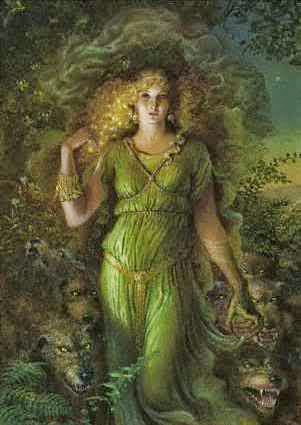Celtic Fertility Goddesses
In the Matres, primarily goddesses of fertility and plenty, we have one of the most popular and also primitive aspects of Celtic religion. They originated in an age when women cultivated the ground, and the Earth was a goddess whose cult was performed by priestesses. But in course of time new functions were bestowed on the Matres. Possibly river-goddesses and others are merely mothers whose functions have become specialised. The Matres are found as guardians of individuals, families, houses, of towns, a province, or a whole nation, as their epithets in inscriptions show. The Matres Domesticæ are household goddesses; the Matres Treveræ, orGallaicæ, or Vediantæ, are the mothers of Trèves, of the Gallaecæ, of the Vediantii; the Matres Nemetiales are guardians of groves. Besides presiding over the fields as Matres Campestræ they brought prosperity to towns and people.141 They guarded women, especially in childbirth, as ex votos prove, and in this aspect they are akin to the Junones worshipped also in Gaul and Britain. The name thus became generic for most goddesses, but all alike were the lineal descendants of the primitive Earth-mother.142
Popular superstition has preserved the memory of these goddesses in the three bonnes dames, dames blanches, and White Women, met by wayfarers in forests, or in the three fairies or wise women of folk-tales, who appear at the birth of {}children. But sometimes they have become hateful hags. The Matres and other goddesses probably survived in the beneficent fairies of rocks and streams, in the fairy Abonde who brought riches to houses, or Esterelle of Provence who made women fruitful, or Aril who watched over meadows, or in beings like Melusine, Viviane, and others.143 In Gallo-Roman Britain the cult of the Matres is found, but how far it was indigenous there is uncertain. A Welsh name for fairies, Y Mamau, "the Mothers," and the phrase, "the blessing of the Mothers" used of a fairy benediction, may be a reminiscence of such goddesses.144 The presence of similar goddesses in Ireland will be considered later.145 Images of the Matres bearing a child have sometimes been taken for those of the Virgin, when found accidentally, and as they are of wood blackened with age, they are known as Vierges Noires, and occupy an honoured place in Christian sanctuaries. Many churches of Nôtre Dame have been built on sites where an image of the Virgin is said to have been miraculously found—the image probably being that of a pagan Mother. Similarly, an altar to the Matres at Vaison is now dedicated to the Virgin as the "good Mother."146

